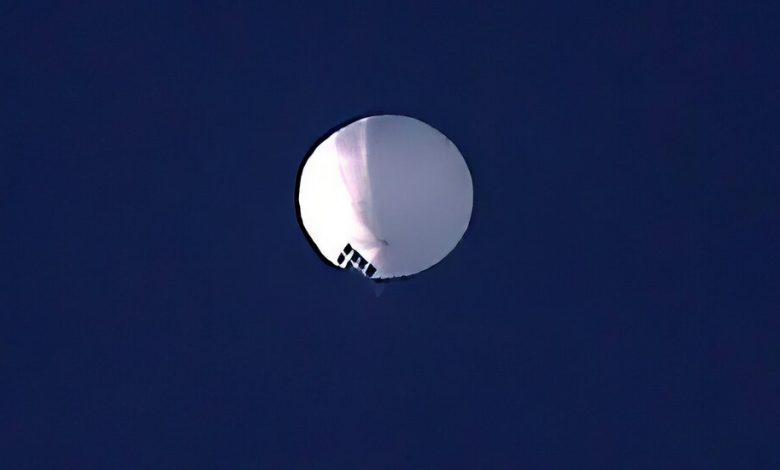Look! Up in the Sky! It’s a … Chinese Spy Balloon?

WASHINGTON — As far as spy thrillers go, this one was not exactly a nail-biter: A giant Chinese spy balloon was spotted air-dawdling its way toward the Eastern Seaboard.
The lumbering orb, drifting at about 60,000 feet, has done nothing to ease the tension between the United States and China, but the timing of it all seemed right for obsessing. It was a cold couple of days in February. People had time to think up some questions.
Could it be shot down? Should it be shot down? Wasn’t there some other runaway balloon, years ago, with a kid inside it? Can that be right? Anyway, what does it say about us that we are so fixated on mysterious floating objects?
As it turns out, there are people who think deeply about this sort of thing. Greg Garrett, a professor who teaches literature, pop culture and theology at Baylor University, says humans are hard-wired to be threatened by things that we don’t recognize.
“As human beings, to look up in the sky and see something we’re powerless over makes us crazy,” he said. “It’s one part of the political reaction, which is, ‘we’ve got to shoot this thing out of the sky,’ regardless of the difficulty and the danger.”
So far, that has not happened.
Before it became an international obsession and a source of diplomatic panic, the balloon first appeared as a rural unsolved mystery. On Wednesday, a sudden ground stop at the Billings Logan International Airport in Billings, Mont., caused residents to cast their eyes skyward.
James Goossen, a page designer at the Billings Gazette, said he and his colleagues had gathered in a parking lot outside the newspaper for their first glimpse of the balloon. He recalled the group’s initial reaction: “Holy crap.”
Better Understand the Relations Between China and the U.S.
The two nations are jockeying for influence on the global stage, maneuvering for advantages on land, in the economy and in cyberspace.
- Spy Balloon: A Chinese surveillance balloon floating over the United States has been raising a lot of questions for people who live under its path.
- Wooing Indonesia: China and the United States are engaged in the strategic battle for influence over the resource-laden nation of nearly 300 million people. So far, Beijing has the edge.
- The Philippines’ Role: The U.S. military is expanding its presence in the Philippines, a sign that the United States is positioning itself to constrain China’s armed forces and bolstering its ability to defend Taiwan.
- Investing in Mexico: Alarmed by shipping chaos and geopolitical fractures, exporters from China are setting up factories in Mexico to preserve their sales to the United States.
Flash forward several days, and the story is suddenly much more complicated, and the undercurrent of danger is more pronounced. President Biden, who first heard about the balloon on Tuesday, is getting regular briefings and asked his top generals to review military options. (They have avoided shooting the balloon down because of the possibility of injuring people on the ground.) The Pentagon determined that it was, in fact, a Chinese surveillance device, and Secretary of State Antony J. Blinken postponed his trip to China.
The diplomatic fallout was swift and the political reaction, as usual, was split.
“Shoot. It. Down. The Chinese spy balloon is clear provocation. In Montana we do not bow. We shoot it down. Take the shot,” Representative Ryan Zinke, a Republican of Montana, tweeted on Thursday. Within 24 hours, former President Donald J. Trump had posted online and sent an email to his followers. His message was concise: “SHOOT DOWN THE BALLOON.”
The Biden White House took a more cautious approach. Karine Jean-Pierre, the White House press secretary, said the balloon did not present a military threat but called its presence a “violation of our sovereignty.”
As more Americans logged on to stare at the balloon on Friday, a spokesman for the Pentagon said the U.S. military was not going to be providing regular updates on its whereabouts. On Friday, the balloon remained in the sky, above the “center of the continental United States,” Brig. Gen. Pat Ryder, the Pentagon press secretary, said.
“What we’re not going to do is get into an hour-by-hour location of the balloon,” he added. “The public has the ability to look up in the sky and see where the balloon is.”
Beijing said on Friday that the craft was indeed from China, but described it as a “mainly meteorological” blimp that had strayed (very) far from its original course. The spotting of a second balloon — this time over South America, on Friday night — made the coincidental-lost-balloon theory much less likely.
Still, the brouhaha briefly called us back to the early days of collective social-media viewing, when it was still novel to watch something bizarre unfold on television alongside a cascade of tweets and cackle-inducing memes. Recall that time in 2009, when it seemed like the entire country was captured for several hours as some sort of large silver bag — thought at first to be carrying a six-year-old boy, of all things — zipped around in the sky over Colorado.
It was the day Balloon Boy was born. After the boy, named Falcon, was found hiding out in the attic of his house, his parents were convicted of misleading a public servant and falsely reporting an incident.
They were later pardoned, and their lawyer called the whole matter “balloonacy.”
In 2012, balloon enthusiasts around the globe were again transfixed as Felix Baumgartner, an Austrian daredevil, rode a helium balloon to an altitude of 128,100 feet, breaking the sound barrier before landing safely back on the ground. That event set a livestream record, racking up some 9.5 million views.
Will Leitch, a novelist and contributing editor at New York Magazine who writes about internet culture, said that, given the range of technological options available to dueling superpowers, there was an absurdist element to the idea that a “menacing balloon” could be a harbinger of conflict between the United States and China.
“I understand arguments to the idea that a balloon could have some sort of spying technology and could be threatening to us,” Mr. Leitch said. “Also, I just kind of think it’s weird to be afraid of a balloon.”
“It seems like a prank that someone would pull in the 1920s,” Mr. Leitch added.
Those who have built and studied these balloons say not to be fooled by this one’s steampunk-looking exterior.
The balloon likely masks formidable technology, according to Art Thompson, an aerospace engineer whose company, Sage Cheshire, worked with the Red Bull Stratos team to design and build the 600-foot-tall balloon that pulled Mr. Baumgartner toward the sky.
Mr. Thompson — who was also part of a team at Northrop Corporation that helped design the B-2 Spirit, the so-called stealth bomber used by the U.S. military — studied images of the balloon and said that the one floating over Montana was outfitted with solar panels, a control panel — and, it appeared, a parachute system. Balloons of this type, he said, can be controlled by radio signals and a system that adjusts air compression and, with it, the balloon’s altitude. The crafts can use solar power to collect radio data, communications signals and even phone data.
“You could collect a lot of information from a balloon, and it has a very long reach,” Mr. Thompson said. “They could be collecting a lot of data to analyze for future applications.”
The slow-moving nature of the balloon — a speed he estimated at 17 to 18 miles per hour, based on its height and surrounding wind patterns — is also likely not an accident. The longer the crafts can linger above one place, the longer they can collect data.
Mr. Thompson and his team, which includes a meteorologist, predicted that the balloon, supposing it is not shot down, could end up scooting across the sky toward Florida and Georgia and off the coast, where it could be safely destroyed or deflated by the U.S. military.
Either way, Mr. Thompson said, the saga could play out for several more days before the balloon reaches a place where it could be taken down safely.
“It’s going to take a while,” he said. Which means our balloon obsession might not be over just yet.



